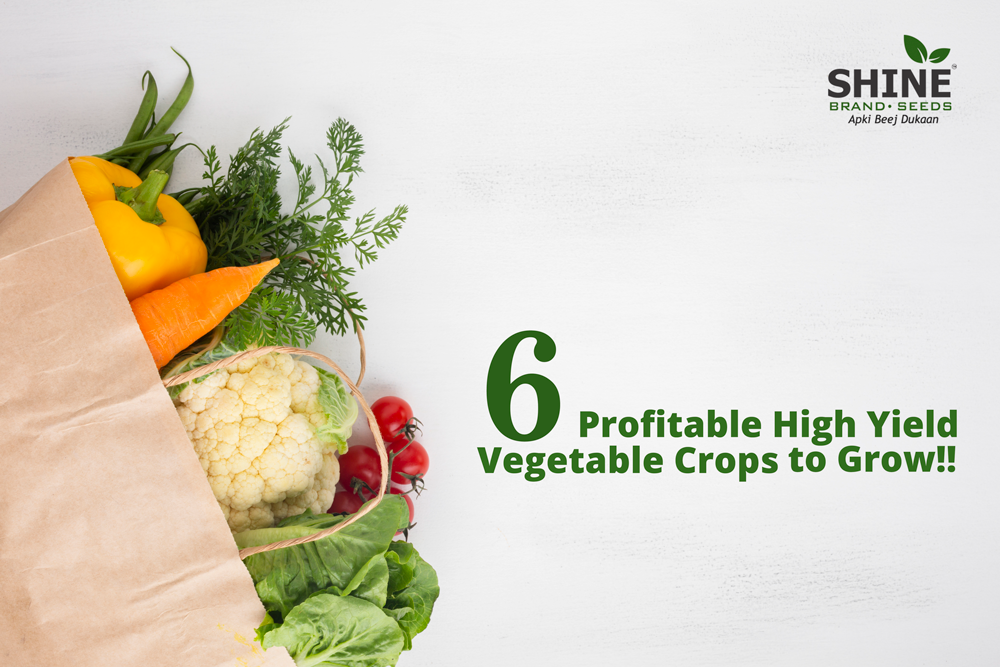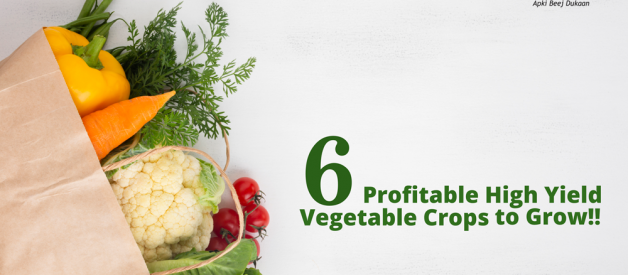
Introduction:
High-yield vegetable crops are those that have been grown, genetically modified, or fertilized to improve their production yields. The world?s growing population is largely dependent on the ability of the agricultural industry to raise high yielding food crops.
Some of the Important High Yield Vegetable Crops
List of high yield vegetable crops can be given below;
Cucumbers
Cucumber farming can be very profitable and high yield if done in the right way. Cucumbers are scientifically known as Cucumis Sativus. Pickling, slicing and seedless are the different varieties of cucumber. Cucumbers originated in India and it is a climbing plant which is used as summer vegetable throughout in India.
Cucumber can be sown in a variety of soils ranging from sandy loam to heavy soil. But a loamy soil that is rich in organic matter and has a good drainage system is best for cucumber farming. The pH ranging from 6 to 7 is suited best for cucumber farming.
For cucumber plantation, it needs well prepared and weed-free field. To bring soil to a fine tilth, 3 to 4 ploughings must be done before planting. Farm Yard Manure such as cow dung is mixed with soil to enrich the field. Then nursery beds are arranged to have a width of 2.5m and at a distance of 60cm. The seed rate of 1.0 kg is sufficient for one acre of land. Before sowing seeds, treat them with the appropriate chemical to protect them from disease and pests and to increase viability.
In the summer season, it requires frequent irrigation and in the rainy season, it does not need any irrigation. In total it requires 10 to 12 irrigations. Pre-irrigation is necessary before sowing then subsequent irrigation is required after 2?3 days of sowing. After the second sowing, the crops are then irrigated at an interval of 4 to 5 days. Drip irrigation is useful for this crop.
Harvests start from 35 to 45 days when hybrid slicing varieties are planted. Cucumber plants can grow under tropical conditions. Cucumbers can be developed under protected cultivation (Greenhouses, polytunnels or net houses) and in open fields.
In an acre area, around 12000 cucumber plants are planted (3 plants per square meter) and each plant yields an average of 5 to 7 kg per cycle. This will yield about 8,400 to 10,500 plants per acre.
Squash
Squash is a high yield and warm-season crop. It is an herbaceous annual vine and its fruits come in a variety of shapes, sizes, and colors. The Squash crop belongs to the family of Cucurbitaceae. Squash is a rich source of Vitamin A, calcium and phosphorus. It can be produced in polyhouse, greenhouse and shade net house.
It is grown in a variety of soils ranging from sandy loam to loamy soil that is ideal for squash farming. The pH soil ranging from 5.5 to 6.5 is optimum for summer squash farming.
For squash farming, use a seed rate of 2kg per acre. Before sowing, the seed is soaked in water for 12 to 24 hours and it will increase germination percentage. To protect seed from soil-borne fungus, treat squash seed with Carbendazim@2 gram/kg of seed or [email protected] gram/kg of seed before sowing. After chemical treatment, treat squash seed with Trichoderma Viride@4 gram/kg of seed or Pseudomonas fluroscens@10 gram/kg of seed.
Immediate irrigation is necessary after seed sowing and then subsequent irrigation is given at an interval of 6?7 days depending upon the season. In total, 9 to 10 irrigations are required.
Depending upon variety and season first picking is done after 60 to 80 days of sowing. Harvesting squash is done after 7 days of fruit set. Picking must be done at an interval of 2?3 days.
In general, each squash plant produces 5 to 25 pounds of yellow squash during the growing season. A 10-foot row of yellow squash averages 20?80 pounds of squash.
Beans
The beans belong to the family Leguminosae and considered high yield vegetables. Beans are growing in soil with normal fertility. Beans don?t require supplemental fertilizer as they fix their own nitrogen. However, poor soil must still be amended with aged manure or compost in the fall prior to planting.
Well-Drained loamy soil with a pH range of 5.5 to 6.0 with a cool climate is suited for bean cultivation. Seeds are best down directly in the ground anytime after the last spring frost; minimum soil temperature is 48 F. Don?t plant too early or the cool soil will delay germination and seeds could also rot.
Mulch soil to retain moisture; that it is well-drained. Beans have shallow roots so mulch maintains them cool. Water regularly, from the start of the pod to set, about 2 inches per week and if you do not keep beans well watered, they will stop flowering. Water on sunny days thus foliage will not remain soaked.
Harvest beans in the morning time when their sugar level is highest. Green beans are picked young and tender before the seeds inside have fully produced. Pick green beans every day; the more you pick, the more beans will grow. The average yield is 100 to 120 quintals of green pods per hectare can be expected.
Tomatoes
Tomato cultivation is one of the most profitable agriculture businesses. Cultivating tomato is an excellent option for those looking to harvest a commercially important crop 4 times a year. A warm but cool climate is required for tomato. It cannot withstand frost. Though, it cannot tolerate high light intensity as well since it affects the fruit pigmentation.
Although tomato requires a diverse set of climate for its growth, it can grow on all types of soils from light sandy soil to heavy clayey soil. Well-Drained soil with a depth of 15 to 20 cm is ideal for yielding a healthy crop. Though, for a heavy yield, farmers cultivate tomatoes on silt-loam soils.
Soil pH level falling in the range of 6.0 to 7.0 is preferred. A slight liming along with adequate nutrient supply can help tomato crops produce better in acidic soil. Seeds of tomato are used for tomato farming. The field for growing tomatoes should be thoroughly decimated and fragmented through repeated plowing. It needs about 5 ploughings before tomato cultivation.
Tomatoes can be harvested within 2 to 3 months of a plantation. Depending on the market demand, 8 to 10 harvesting of tomato is done on a yearly basis. The average tomato crop yield per acre in India is about 10 tonnes although the yield varies from 15 to 20 tonnes per acre in case of irrigated crops.
Peanuts
Peanut is widely grown in the tropics and subtropics, important to both small and large commercial growers. It is an annual herbaceous plant that may reach up to 50 cm in height.
Climatic conditions such as temperature and rainfall significantly influence Peanut farming. Temperature is the main environmental factor that determines the rate of crop development. Temperature ranges above 35C inhibit the growth of Peanut.
Moisture is another critical factor for successful Peanut farming. Planting should be done on moist warm soils to speed-up the germination process.
Peanuts produce best in well-drained, red-colored, yellow-red and red, fertile, sandy to sandy loam soils with a pH level of 5.5 to 7.0. Saline soils are not appropriate because Peanuts have a very low salt tolerance.
Grown mainly through age-old farming techniques, peanut yield in India is about 700?900 kg per hectares.
Potatoes
Potato is an important food crop in the world. Potato is a temperate crop developed under subtropical conditions in India. The varieties should create the best use of the agro-climatic conditions and give a high yield.
This can be grown almost on any type of soil except saline and alkaline soils. Soils, which are naturally loose, offer the least resistance to the enlargement of the tubers is chosen. Loamy and sandy loam soils, rich in organic matter with good drainage and aeration are most appropriate for the cultivation of potato crops. The soil with a pH level of 5.2?6.4 is considered to be ideal.
The vegetative growth of the plant is best at a temperature range of 24C while tuber development is favored at 20C. Potato is generally cultivated by planting tubers. The purity of the cultivars and healthy seed tubers are the primary requirements for a successful potato crop.
The time of harvest is important in potato. The growth of the tuber continues till vines die. The major crop is ready for harvest within 75?120 days of planting depending upon the area, soil type, and variety sown. In the hills, the crop must be normally harvested when the soil is not very wet.
During the first year of cultivating potatoes, a good yield can be 10 tons per acre. Experienced farmers after years of practice can achieve yields from 16 to 28 tons per acre.
Some of the other high yield vegetables can be given below;
Peppers:
The yield per acre of pepper is 0.39 tonnes per hectare. This indicates a plant population of 10,250 plants per acre, thus the average yield per plant is about 3.6 pounds.
Beetroot:
The beetroot crop yields about 20?25 t/ha in 120 days.
Radishes:
It yields about 200 to 250 quintals fresh radish per hectare.
Lettuce:
The average yield of lettuce is 80 to 120 quintals per hectare.
Summary
These are the 6 most profitable high yield vegetable crops which will increase your profit. Now you have the detailed knowledge about high yield vegetable crops is that how to grow, about the conditions, temperature and many more.


